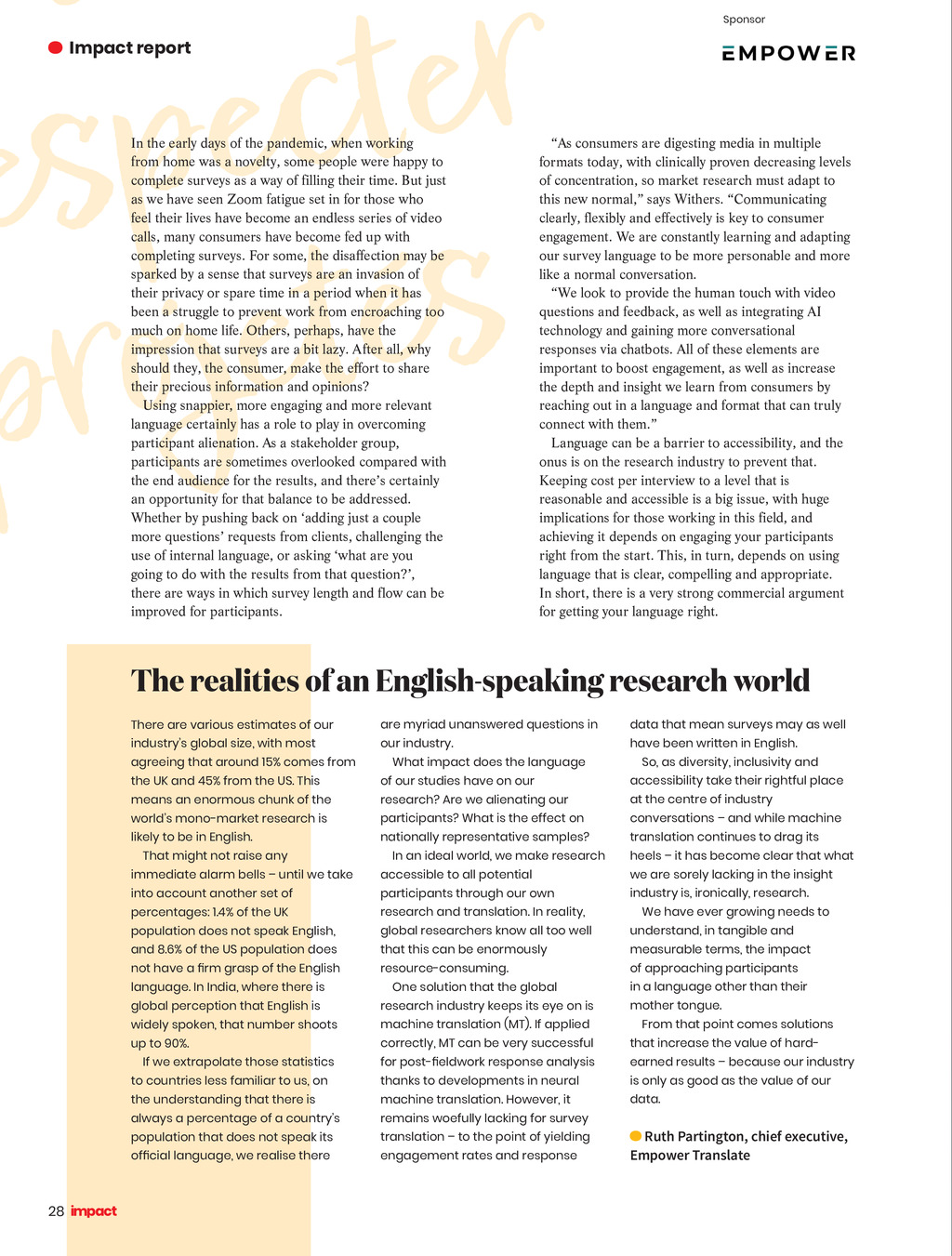




Sponsor Impact report In the early days of the pandemic, when working from home was a novelty, some people were happy to complete surveys as a way of filling their time. But just as we have seen Zoom fatigue set in for those who feel their lives have become an endless series of video calls, many consumers have become fed up with completing surveys. For some, the disaection may be sparked by a sense that surveys are an invasion of their privacy or spare time in a period when it has been a struggle to prevent work from encroaching too much on home life. Others, perhaps, have the impression that surveys are a bit lazy. After all, why should they, the consumer, make the eort to share their precious information and opinions? Using snappier, more engaging and more relevant language certainly has a role to play in overcoming participant alienation. As a stakeholder group, participants are sometimes overlooked compared with the end audience for the results, and theres certainly an opportunity for that balance to be addressed. Whether by pushing back on adding just a couple more questions requests from clients, challenging the use of internal language, or asking what are you going to do with the results from that question?, there are ways in which survey length and flow can be improved for participants. As consumers are digesting media in multiple formats today, with clinically proven decreasing levels of concentration, so market research must adapt to this new normal, says Withers. Communicating clearly, flexibly and eectively is key to consumer engagement. We are constantly learning and adapting our survey language to be more personable and more like a normal conversation. We look to provide the human touch with video questions and feedback, as well as integrating AI technology and gaining more conversational responses via chatbots. All of these elements are important to boost engagement, as well as increase the depth and insight we learn from consumers by reaching out in a language and format that can truly connect with them. Language can be a barrier to accessibility, and the onus is on the research industry to prevent that. Keeping cost per interview to a level that is reasonable and accessible is a big issue, with huge implications for those working in this field, and achieving it depends on engaging your participants right from the start. This, in turn, depends on using language that is clear, compelling and appropriate. In short, there is a very strong commercial argument for getting your language right. C M Y CM MY The realities of an English-speaking research world There are various estimates of our are myriad unanswered questions in data that mean surveys may as well industrys global size, with most our industry. have been written in English. agreeing that around 15% comes from What impact does the language of our studies have on our accessibility take their rightful place means an enormous chunk of the research? Are we alienating our at the centre of industry worlds mono-market research is participants? What is the effect on conversations and while machine likely to be in English. nationally representative samples? translation continues to drag its In an ideal world, we make research accessible to all potential we are sorely lacking in the insight into account another set of participants through our own industry is, ironically, research. percentages: 1.4% of the UK research and translation. In reality, population does not speak English, global researchers know all too well understand, in tangible and and 8.6% of the US population does that this can be enormously measurable terms, the impact not have a rm grasp of the English resource-consuming. of approaching participants One solution that the global We have ever growing needs to in a language other than their mother tongue. global perception that English is research industry keeps its eye on is widely spoken, that number shoots machine translation (MT). If applied up to 90%. correctly, MT can be very successful that increase the value of hard- From that point comes solutions for post-eldwork response analysis earned results because our industry to countries less familiar to us, on thanks to developments in neural is only as good as the value of our the understanding that there is machine translation. However, it data. always a percentage of a countrys remains woefully lacking for survey population that does not speak its translation to the point of yielding ofcial language, we realise there engagement rates and response If we extrapolate those statistics K heels it has become clear that what immediate alarm bells until we take language. In India, where there is CMY So, as diversity, inclusivity and the UK and 45% from the US. This That might not raise any CY Ruth Partington, chief executive, Empower Translate 28 Impact ISSUE 37 2022_pp20-29_Report.indd 28 28/03/2022 14:57